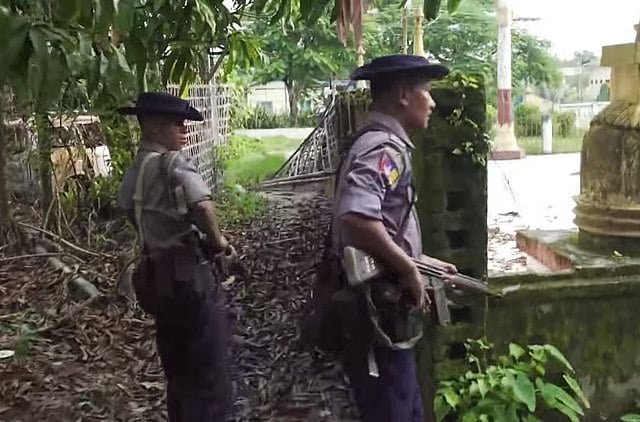Reuters has published an extensive report of the Myanmar massacre of 10 Rohingya men in September, pulling from photographs, documents and eyewitness accounts obtained by two Reuters journalists.
The report describes in great detail how-how villagers and paramilitary forces killed the men execution-style and buried them in one grave.
While working on the Myanmar massacre story in Rakhine state, the two Reuters journalists were arrested by Myanmarese authorities. Accused of violating the Official Secrets Acts, the men, Wa Lone and Kyaw Soe Oo, have been detained since December 12 and face up to 14 years in prison.
The two journalists have been accused under Section 3.1 (c) of the act, which covers entering prohibited places, and taking images or obtaining secret official documents that “might be or is intended to be, directly or indirectly, useful to an enemy,” Reuters reported earlier this week.
The journalists’ detention has prompted outcry from governments and human rights groups around the world. Government officials from some of the world’s major nations, including the United States, Britain, and Canada, as well as top U.N. officials, have called for the reporters to be freed.
A spokesperson for Reuters said that the two detained men were innocent of any wrongdoing and that they were arrested for doing their jobs, as “journalists who perform a crucial role in shedding light on issues of global interest.”
“We believe that the ongoing court proceedings will demonstrate their innocence and they will be able to return to their jobs reporting on events in Myanmar. We are grateful for the expressions of support for Wa Lone and Kyaw Soe Oo and continue to call for their prompt release,” the statement said.
Despite the men being detained for eight weeks, first in police custody and then in Yangon’s notorious Insein prison, as well as being denied bail at their last hearing, the results of their controversial work had now been published by Reuters.
Titled “Massacre in Myanmar,” the story describes how, in early September, paramilitary troops and Buddhist villagers tied 10 men together and killed them with machetes and gunfire.
The persecuted Rohingya Muslims in Myanmar have been targeted in a wave of violence denounced by the United States as “ethnic cleansing.” According to NPR, more than 6,700 Rohingya Muslims were killed in a single month in the Rakhine State alone.
Reports from Doctors Without Borders suggest that the Rakhine State, situated on the western coast of Myanmar, was where the conflict that led to the Myanmar massacre originally erupted.
Hundreds of thousands of Rohingya refugees have fled the Myanmar massacre, setting up in makeshift camps along the border with Bangladesh. According to NPR’s Jason Beaubien, the conditions in most of these refugee camps are “dire.”
Photographs acquired on the scene, along with testimonies from Rohingya refugees, were used in the latest Associated Press report on the use of mass graves to conceal the Myanmar massacre of Rohingya prisoners.
Reuter’s report is in line with AP’s report and describes in graphic, disturbing detail the account of atrocities in the Myanmar massacre.
“Until now, accounts of the violence against the Rohingya in Rakhine state have been provided only by its victims. The Reuters reconstruction draws for the first time in interviews with Buddhist villagers who confessed to torching Rohingya homes, burying bodies and killing Muslims,” the report said.
Reuters reporters said members of the paramilitary police gave insider descriptions of the operation to drive out the Rohingya from Inn Din and confirmed that the military played the lead role in the Myanmar massacre.
The team of journalists working on the report managed to identify all 10 of the slain men in the photos and talk to their families and neighbors, thanks to a Buddhist village elder who provided them with the photo. The man said he wanted transparency, as well as to prevent such killings in the future, the report said.
The controversial report also includes photographs of the mass grave sites that were taken by Wa Lone, one of the journalists detained for working on the Myanmar massacre story.
Myanmar military confirmed that their troops were responsible for killing the 10 men on the photo, making it the first time any state officials have taken responsibility for the atrocities that have happened in the Myanmar massacre.
Military officials have said that the men were killed after they carried out a massive attack on Myanmarese troops. However, their statement doesn’t match any account of the killings that Reuters heard from paramilitary forces or local villagers.
Reporter Michael Sullivan told NPR in December that the only reason the military has acknowledged the existence of this mass grave is that they knew that the photos connecting them with the Myanmar massacre were out there.
Reuters’ report uncovered that the 10 men on the photograph had been selected from hundreds of Rohingya men, women and children who fled the Myanmar massacre and sought safety on a beach.




